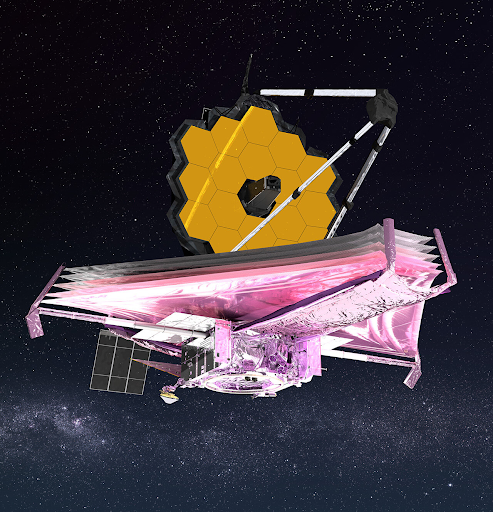The James Webb Telescope Explores the Past in the Present

May 4, 2023
Time travel–so far–is not possible. The speed of light, the cosmic speed limit so to speak, is an insurmountable barrier for mass-carrying beings such as ourselves and our vehicles. So how are scientists able to predict the age of the universe or the galaxies that surround us if we can’t possibly visit them? Well, what stops us actually helps us.
Space is so unfathomably large that even light has a tough time traversing it. The closest known galaxy to us, the Canis Major Dwarf Galaxy, is 25,000 light years away. That means that light from the millions of stars that inhabit it takes 25,000 years to reach us. And since light travels at about 3×108 m/s–yep, that’s 300 million meters traveled every second!–the Canis Major Dwarf Galaxy is approximately 2.3652×1020 meters or 236 quintillion meters away (NASA Goddard Space Flight Center).
Whenever you look up at the night sky, the light you see is not actually the present state of the star or the planet you observe. In some cases, light must overcome massive distances before it reaches your eye. The time that passes is equivalent to the age of the light you are looking at. You might see a star that was born millions of years ago, but its light is just reaching you at that moment. This promotes endless possibilities for astronomical study.
The James Webb Space Telescope or JWST for short, was launched Christmas of 2021 and is tasked with discovering the birthdate of the Universe along with what lies nearby. The JWST utilizes various infrared-sensing technologies to observe electromagnetic radiation that has been red shifted due to the expansion of the universe (NASA Webb Space Telescope Fact Sheet).
To start, light is a form of electromagnetic radiation that is visible to the human eye. The electromagnetic spectrum is ordered by wavelength with the longest wavelengths (radiowaves and microwaves) at the beginning and the shortest wavelengths (x-rays, ultraviolet, and gam rays) at the end. Visible light lies at about the midpoint of the “number line.” Within the confounds of visible light are all of the colors we are familiar with, aka ROYGBIV.
Infrared radiation, which the JWST analyzes, lies directly below the color red on the electromagnetic spectrum. In fact, it’s in the name itself: infra is Latin for below, thus infrared translates to below red. This means that infrared radiation has a longer wavelength than light. But how does this become emitted from galaxies far, far away? The simple answer is that the universe is constantly expanding.
As light travels from one point to another, it will maintain its frequency and wavelength. However, since space is expanding, the source is moving away from its destination which will cause the light to also expand. The farther you are away from the source of the light the more the light is stretched before it reaches you. This can cause the light to no longer be light at all. It enters into the infrared region which is invisible to the human eye. This helps the JWST to pinpoint the oldest, farthest galaxies.
The ability of observing the infrared radiation emitted from cosmic structures has led to some mind boggling theories. Erica Nelson, an astrophysicist at the University of Colorado Boulder, uses the data from the JWST to better understand the universe’s distant past. “The most exciting piece of this telescope, of this remarkable instrument we put in space, is finding things that we didn’t expect that we can’t explain because that means that we have to revise our understanding of the universe,” says Nelson (60 Minutes).
According to some of the data regarding a few very distant galaxies, their early birthdates do not seem to make any sense given the current estimation of the Big Bang, the beginning of time itself. “It’s bananas,” says Nelson, in a recent article from CBS Colorado. “You don’t just expect the universe to organize itself that quickly.”
As the JWST continues to meander through outer space, our current understanding of the universe will constantly be questioned. And given its projected 25 year mission length, there is no doubt that new discoveries are just around the corner.
For more information regarding the JWST and the images it is currently collecting, visit the mission website: https://webbtelescope.org/





























